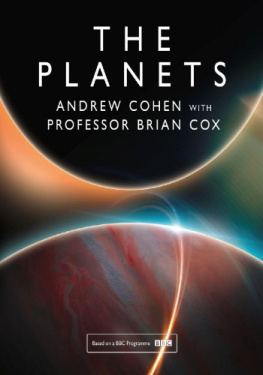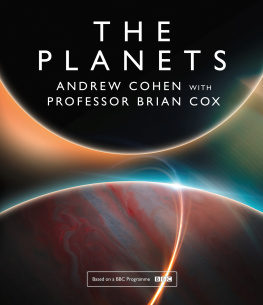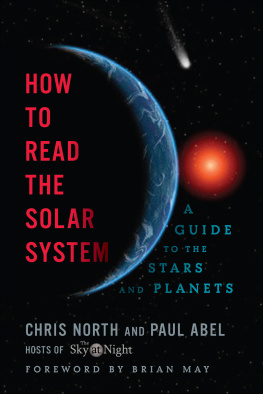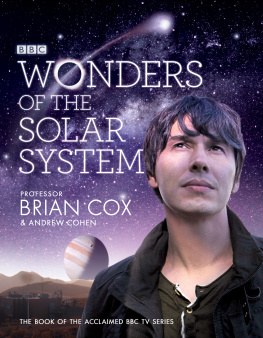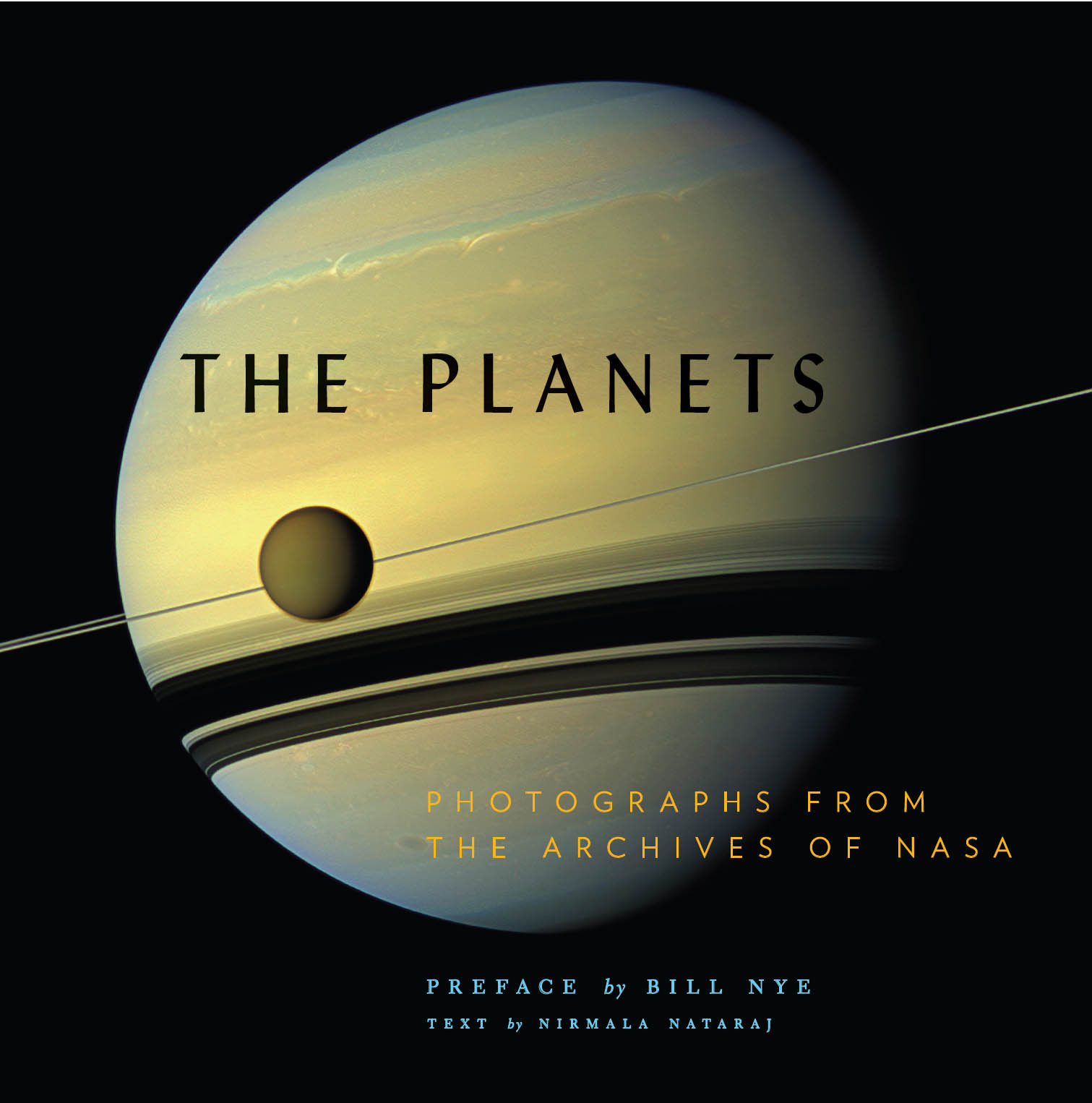

Text copyright 2017 by Chronicle Books LLC .
All rights reserved. No part of this book may be reproduced in any form without written permission from the publisher.
ISBN 9781452160467 (epub, mobi)
Library of Congress Cataloging-in-Publication Data
Names: Nataraj, Nirmala. | Nye, Bill. | United States. National Aeronautics and Space Administration.
Title: The planets : photographs from the archives of NASA / preface by Bill Nye ; text by Nirmala Nataraj.
Description: San Francisco : Chronicle Books, [ 2017 ] | Includes bibliographical references.
Identifiers: LCCN 2016046135 | ISBN 9781452159362
Subjects: LCSH : PlanetsPictorial works. | Solar systemPictorial works.
Classification: LCC QB501.2 .N38 2017 | DDC 523.4dc23 LC record available at https://lccn.loc.gov/2016046135
BOOK DESIGN AND IMAGE RESEARCH BY Neil Egan
Chronicle Books LLC
Second Street
San Francisco, California 94107
www.chroniclebooks.com
[ ]
SATURN AND TITAN
Saturns largest moon, Titan, is shown against the giant planet in this image captured by Cassinis wide-angle camera in 2012. This natural color mosaic was created by combining six images taken through red, green, and blue spectral filters.
CONTENTS

SWIRLS IN THE GULF OF ST. LAWRENCE
An astronaut aboard the International Space Station ( ISS ) in 2016 captured this remarkable image of swirling eddies in the Gulf of St. Lawrence in eastern North America. The swirls form as a complex network of flows come together in the shallow waters off the coast of Prince Edward Island. These currents are made visible here by the particular angle of the Sun reflecting off the water.
YOURE AN EXPLORER
by Bill Nye
W ELCOME , space explorer! I hope by the time you read this part of the book, youve already spent a good bit of time admiring the pictures. They are astonishing. You are looking at images with a clarity and sharpness that our ancestors probably couldnt even imagine, let alone capture. After all, it wasnt until quite recently, in the course of human affairs, that anyone fully grasped what it means to live upon a spherical planet gravitationally suspended in the stark blackness of space. It was only in the last sixty years that humans could conceive, design, build, launch, and fly spacecraft above other celestial bodies. And although astronomers of 600 years ago had an excellent sense of how big our Earth is, it wasnt until the last few decades that we could see our neighboring celestial bodies up close, as you can right here in your hands.
Your journey begins right here as you turn these pages. With each page, youll make a discovery. You can see with utter clarity the similarities between the inner terrestrial planets. Marvel at the ancient traumas of Mercury. Try counting the craters of impacts in an area the size of your palm. Those meteoric collisions took place millennia ago, mostly. But those perfect rings and mounds are eerie reminders of how much damage a primordial rock could do, if one were to arrive unwelcome and unannounced here on Earth. Move beyond the Sun, and Venus is revealed in a way that very, very few humans have heretofore ever seen. Fly out farther and relax your gaze on scenes from the very surface of Mars. With some thought and attention to detail, try imagining a route for our next rovers expedition as we search for life on the red planet. Such a discovery, of Martian microbes, say, would change the course of human history.
As you make your way further into the book youll find yourself farther from the Sun. The gas giants loom large in your lap. You can marvel at the magnificent storms of Jupiter and the astonishing hexagonal vortex of Saturn. And the rings! Saturns rings are wide like the brim of a state troopers hatwide and flat. Uranuss are very thin and were completely unknown when I was born. Just think what else is out there for humankind to discover. I like to believe that these photos will carry your imagination to places that no one else has ever considered.
This book reminds us of two questions that all of us ask at some point in our livestwo ideas that we find so compelling that space agencies around the world pursue the answers with rockets and probes and imagers to the far reaches of our solar system: Where did we come from? And, are we alone out here in the cosmos, way out here, suspended on an arm of the Milky Way? To find your own answers to these universal questions, save the best for last and look at our Earth from space as astronauts do. It will change you. Read on, explorer!
OUR SOLAR SYSTEM
T HE ORIGINS of our solar system remain shrouded in mystery. To this day, scientists scratch their heads over the matter of how our cosmic neighborhood was formed.
We know a few things. To begin with, our solar system was fully up and running around 4.568 billion years ago. Before that it only existed as a formless potential in the midst of a cloud of cold gas and dusta solar nebulathat was many light-years in diameter.
Although we dont know exactly what precipitated the formation of our solar system, some scientists surmise that a supernova explosion in the vicinity impacted the solar nebula, causing it to collapse. This episode created dense, gravity-rich areas, where matter was sucked into countless pockets of gas and dust. These areas became cradles that nurtured the formation of stars, including our Sun.
In the pocket where our Sun was born, material from the solar nebula accreted into a ball at the center, while other matter dispersed in a disk that settled around the embryonic Sun. Its likely that the Sun began as a T Tauri stara new star in which nucleosynthesis (the process during which elements heavier than helium are created through fusion) has not yet begun. After about fifty million years, the temperatures and pressures were high enough to incite fusion (the process during which hydrogen is converted into helium, and tremendous amounts of heat and energy are released). Thats when our Sun as we know it was born.
The changes didnt end there. Material orbiting the Sun continued to collide, sometimes forming larger objects or splitting off into smaller bits of cosmic debris. Most planets began as wayward particles of dust that came together over time.
Today, aside from our eight planetsMercury, Venus, Earth, Mars, Jupiter, Saturn, Uranus, and Neptunethe solar system is home to a diverse family of celestial bodies: dwarf planets, asteroids, and the comet-rich Kuiper Belt that exists just beyond Neptune.
THE ORIGIN OF THE PLANETS
The planets started out as infinitesimal grains of dust in the disk around the new Sun. Through small collisions, the grains accumulated into balls of matter called planetesimals, which were about a mile in diameter and sizeable enough to attract other planetesimals through gravity. Collision speeds had to be low enough so that the objects could continue to grow rather than break apart. This process of accretion and collision took place for between ten and one hundred million years.
As some planetesimals merged, others exploded into nothingness. At the end of this long evolution, only eight of the objects remained stable: These are the planets we know today. As the force of gravity pulled the hot, molten material of each planet inward toward its center, each object became spherical in shape. However, the spinning of a planet causes it to counteract the force of gravity, creating a bulge at the equatormeaning that none of the planets in our solar system are perfectly spherical.
Next page

